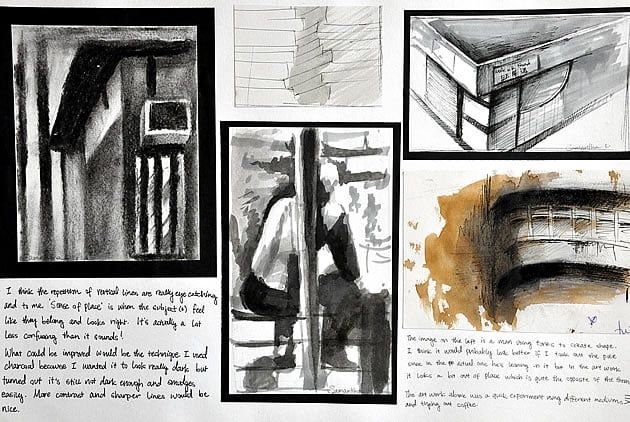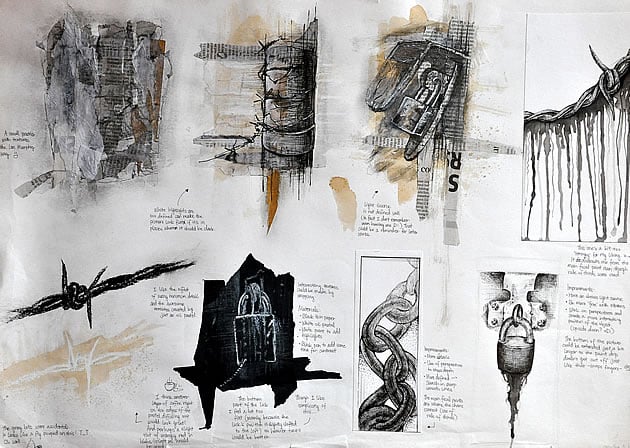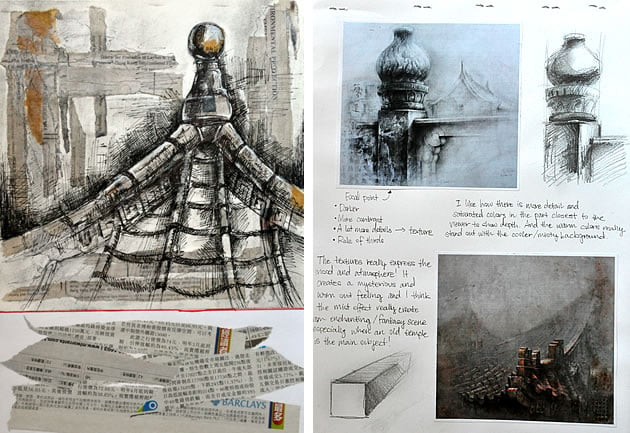Last Updated on April 2, 2023
This Edexcel GCSE Art Coursework project was completed by Samantha Li, while studying at West Island School, Pokfulam, Hong Kong. Samantha gained full marks (120/120 and 80/80) for both her Coursework and Examination. This article contains images of Samantha’s GCSE Art sketchbook pages: outstanding observational drawings of architectural spaces, artist research, development of ideas and experimentation with media.
Two of Samantha’s sketchbook pages are included in our new book: Outstanding High School Sketchbooks. This book has high-resolution images so that fine details and annotation are clear, making it an excellent resource for students and schools. Learn more!
In an interview with the Student Art Guide, Samantha shares the themes she explored – a reflection of daily life and busy routines – and provides insight into how she developed a high level of artistic skill and the ability to work with speed. Her descriptions of the places depicted within her work are breathtaking: indicating a deep connection and understanding of her subject matter – something all IGCSE / GCSE Art students should aspire to.

What was your GCSE Art Coursework topic and why did you select this?
Samantha: My coursework topic was ‘Sense of place’ and, for me, this is expressing culture and sense of belonging through touch, sight, taste, smell, and sound. The first two can easily be communicated through texture and colors, and a combination of these creates an atmosphere that bursts into life.
The city scenes are of Sham Shui Po, Central, Aberdeen and Causeway Bay, all in Hong Kong. For my artwork, I used reference photos I took myself and also drew from life. I was lucky to be living in Aberdeen during that time and often went to the marketplace to buy groceries. It felt good to be part of the busy, yet simple routines. The woman with the red gloves speaking in Cantonese while I just pretend to understand by nodding…the smell of flowers interrupted by the metallic smell of fish. There was so much going on!
As I twisted through the lanes searching for the perfect potato, what visually appealed to me the most were the dripping, grungy walls hidden behind the stalls. A mix between the freshness of vegetables, combined with what looked ancient, seemed somewhat natural, which makes it beautiful. It’s like that feeling when looking at the hands of an aged farmer, it’s beautiful!

Your Coursework project contains exceptional gestural drawings. Drawing quickly is something that many students struggle with. How did you develop this skill?
Samantha: When sketching without resources, I rarely think and just jump straight into it. Thinking too much restricts your mind’s ability to use the information it has gathered through experience, so I try to just trust my instincts and adjust it afterwards if it doesn’t look right.
I have done a lot of drawing as a hobby ever since I could hold a pencil. I only started to develop my techniques professionally during the summer of 2012 (towards the end of first GCSE year) when I was introduced to a small, unfamiliar art group by an ex-graphic designer.
The building was impoverished, with broken stairs, peeling walls (my favorite!) and small rooms with no fans or air conditioning. The tropical climate didn’t help much either. However the intensity of the atmosphere distracted me completely from the stickiness of the sixty people around me and the sweat continuously dripping from my forehead. This goes on for nine hours, from 8am to 11:30pm (I try to use only 3hrs per piece), not including lunch and dinner breaks in between.

The other artists were older and more skilled than me. That gave me pressure and the drive to surpass the person beside me. They were all using the building as a studio and practice for art exams to get into universities, so competition was everywhere. I also made a lot of friends that gave me tips and also taught me how to play basketball and pool!
The other artists focused completely on the examination system (which I don’t really understand at all, to be honest) so the sketching ‘rules’ were strict and didn’t have room for imagination. Nearly all the students there had no interest in art and were simply there to get into a university. I guess this was the difference between us that made me improve at such a rapid speed in a short period of time: passion.
I just keep reminding myself of my dream, which is to become someone who adds respect to the art world and reduces the stereotypical belief that ‘people become an artist as last resort’, which is, unfortunately, a common thought among many people I’ve met.

Other than that summer experience, I draw a lot at home for fun, creating dynamic poses and looking up tutorials for interesting techniques. I used to draw for a few hours right after I got home from school, stopping only when my wrist ached. Now, I have an exciting International Baccalaureate life with subjects I enjoy and I spend less time doodling and more time studying and hanging out with friends.
The main things I learned through my experiences:
- We are extremely lucky to live with such great conditions to help reach our full potential (especially if we have air-conditioning).
- Focus on the big picture first, add the details later.
- Art is art, not a photograph!
My journey not only helped me improve technical skill, it helped me build more confidence and develop experiences that are not so art-related.

Which artists did you study as part of your project?
Samantha: During the project, the artists I studied use very different styles and mediums. Most of GCSE was experimentation, so our class was encouraged to try a wide range of techniques, such as pen pressure, layering…
Ian Murphy was the first artist I studied. He came to our school and taught us lots of methods of creating backgrounds, linework, and his art-making process. It opened a whole new world of possibilities in my mind when expressing directional movement and creating effects the traditional way (I was a digital art addict)!
While most of Ian Murphy’s artwork creates a reminder of culture and age by emphasizing the textural attributes, Jasper Knight’s artworks have a more modern and graphical look. His distinctive style includes using solid colors (usually primary) and bold lines that drip. What captures me the most about Jasper Knight’s work is the combination of geometrical features and playfulness, similar to De Stijl and Memphis.
As a digital art lover, I was attracted to Margaret Preston’s color schemes and printmaking technique, which is quite similar to cel-shading. Her artwork express complexity through few colors and strong borders which makes it eye-catching.
Kurt Schwitters was an artist I studied while I was experimenting with collage and composition through basic shapes and materials. I became more open-minded about different materials such as rope, wires, and aluminium foil, all which I have never used before in a painting. His work also gave me ideas on the use of levels (height and density of materials) when printmaking.

Samantha is a multi-talented student: someone to watch. If you enjoyed this article, you may also wish to view Samantha’s International GCSE Art Examination or other exemplary high school Painting and Fine/Art Projects.

